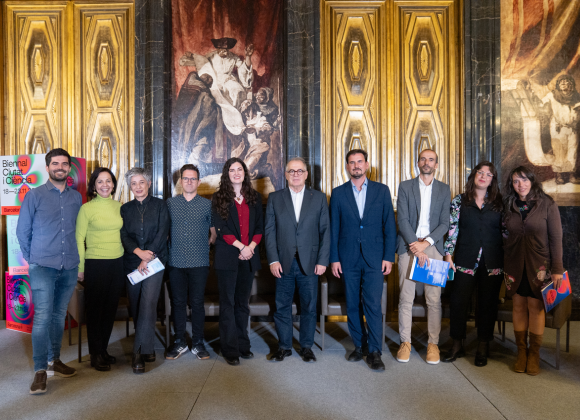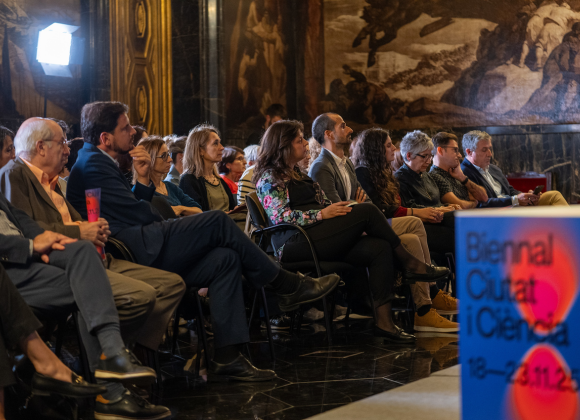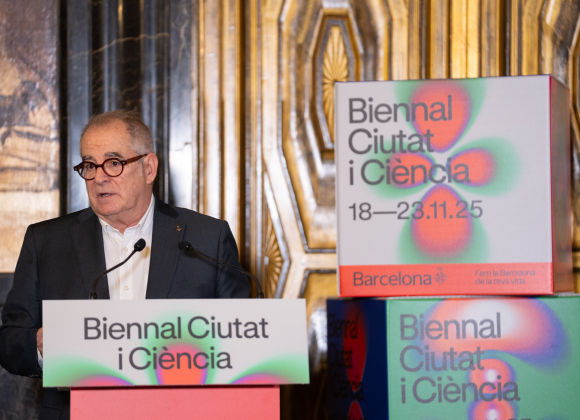The City and Science Biennial programs 130 activities in Barcelona, Madrid and Mexico to bring the quantum revolution closer to citizens
The fourth edition of the City and Science Biennial has scheduled up to 130 activities designed to reflect on and bring the quantum revolution closer to citizens, a discipline that has profoundly transformed the world since the beginning of the 20th century. The event will take place simultaneously from 18 to 23 November in Barcelona and Madrid. On the other hand, and for the first time, it will have an extension to Mexico, between 29 November and 7 December, within the framework of the Guadalajara International Book Fair (FIL), of which Barcelona is a guest city.
The Biennial coincides with the celebration of the International Year of Quantum Science and Technology, and aims to be an ideal space to understand the social change that this discipline has generated in our society through the multiple technological discoveries. Advances in science that also pose new limits and new challenges for the future. Through talks, presentations, debates and scientific dissemination spaces, quantum communications will be addressed from areas such as philosophy, art and thought.
The press conference was attended by the deputy mayor, Economy, Housing, Finance and Tourism and head of the City Council area, Jordi Valls, and the director of the Círculo de Bellas Artes de Madrid, Valerio Rocco, in addition to all the curators of this edition: Alba Cervera, Toni Pou and the HacTe group, programmers of the events in Barcelona, and Elisa Garrido and Carlos Sabín, responsible for the programming in Madrid.
Jordi Valls highlighted that “Barcelona is a city of science because it has been working in this area for many years to promote social and economic progress through the Strategic Plan for Science and Innovation 2024-27 or projects such as the Barcelona Innovation Coast, and because it promotes it. And this is demonstrated by the Biennial: the most important scientific dissemination event in the city and which continues to grow.” In this sense, Valls praised the Biennial’s capacity “to build bridges, first with Madrid, with an already consolidated collaboration, and this year with Mexico, coinciding with the FIL Guadalajara”. He added that “the Biennial allows us to bet on dissemination, to bring citizens closer to the quantum revolution, an area of knowledge that has already brought us great advances, and that Barcelona is starring in with its powerful scientific ecosystem, with large infrastructures such as the ICFO or the Synchrotron”.
Rocco, for his part, highlighted that “for the Circulo de Bellas Artes this project is strategic for two reasons: because - in the spirit of scientific and cultural co-capitalism - it strengthens our connections with Barcelona (already central to our programming) and because it insists on exploring the links between art and science, a crucial commitment for years for our institution.”
The City and Science Biennial is one of the most important scientific culture events held in the city of Barcelona and is a clear example of the commitment made by the city council to promote scientific research and dissemination. In fact, it is one of the outstanding actions of the Strategic Plan for Science and Innovation 2024-27, which focuses on the transfer of knowledge as a driver of progress in society and the economy.
Quantum, in addition, is a strategic sector for Barcelona, as established in the science plan but also in the objectives of the Barcelona Innovation Coast. This is demonstrated by the fact that in the city and its surroundings there are prominent institutions in research in this field, such as the Barcelona Supercomputing Center (BSC), the ALBA Synchrotron or the Institute of Photonic Sciences.
The Biennial is already a consolidated event that reinforces Barcelona's role as the scientific and cultural capital of southern Europe.
Nat Award Ceremony, First Event of the Biennial
Most of the Biennial's activities are concentrated in Barcelona and specifically in the Ciutat Vella district. The center of the Biennial in the city is once again the Born. Barcelona History Museum, but also nearby spaces, such as the Hivernacle in the Ciutadella Park, where the Biennial will be inaugurated on Tuesday, November 18 in the evening. At this event, the Nat Award from the Barcelona Museum of Natural Sciences will be presented to Philip Ball, winner of an award that this year is in its eighth edition and that distinguishes people who bring a new perspective to the dissemination of science.
Science Night, among the highlights of Barcelona
Among the highlights of Barcelona, there is the conversation between physicist Ignacio Cirac, a world reference in quantum computing, and writer Sònia Fernández-Vidal on the current state of quantum technologies. Or the round table “Geopolitics in the Second Quantum Revolution” that will bring together the voices responsible for research centers to debate the risks of a new global technological gap and the role of research institutions in this scenario.
The Biennial is once again celebrating one of its most consolidated activities, Science Night, on Saturday the 22nd, with scientific monologues such as those by Big Van Ciencia, guided tours and interdisciplinary performances. It also repeats the film program, to explore the influence of quantum theory on cinematic language through the screening of three films with a discussion.
On the other hand, the more playful Biennial is also back, which will feature quantum chess and board games, but also experiments, both for schoolchildren and the general public with the aim of exploring how quantum science and technologies allow us to study and understand the world. There will also be, among many other activities, the live broadcast of the Marea Nocturna podcast or Quantum on a Pole, a Pole Dance performance.
An avatar of Albert Einstein, protagonist of the Madrid program
In Madrid, the opening event stands out, which will take place on November 18 at 7 p.m., and will consist of a conversation between María García Díaz, Carlos Sabín and the Albert Einstein avatar. This has been thanks to the technology developed by the Q-Math research group of the Institute of Mathematical Sciences (ICMAT) and the Carlos III University.
Also worth mentioning is the conversation between Marta Peirano and Ignacio Cirac entitled “What is quantum optics?. And the conversation between Carlo Rovelli and Blanca Pujals at the Madrid and Barcelona venues, entitled “Quantum loops between Madrid and Barcelona”. The Madrid program also includes the Open Forum on quantum physics organized by redACTS.
Extension to Mexico: FIL Ciencia
Taking advantage of Barcelona being the guest of honor at the Guadalajara International Book Fair (FIL), the Biennial will have the FIL Ciència extension, a space designed to bring knowledge closer to everyone and awaken scientific vocations among younger people. This extension of the Biennial will feature the participation of prominent voices from the scientific ecosystem who will share their reflections on the great contemporary challenges.
The FIL Guadalajara is a meeting point for the Spanish-language cultural industry, and is the most prominent cultural event in Ibero-America and a global reference. In addition to the scientific program, Barcelona will deploy an intense program of activities that will help show the city's potential in many different areas.
+ Biennial
The main program of the Biennial City and Science is joined, under the +Biennial label, by a set of very diverse activities organized by municipal facilities, cultural centers, universities and other entities that share the goal of bringing science closer to the public. Coinciding with the Biennial, these spaces will offer different proposals that expand and complement the vision of the main program, reinforcing the dialogue between science, culture and society.



